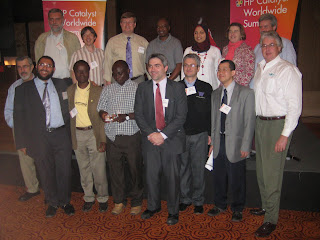(Sorry about the delay in this update...a combination of inconsistent schedules and power have made this a little late. :-) )

We collect for our next set of meetings. This allowed us to do some sharing as to what we learned from the last few days and to report what we discovered. Many of the comments related to the amazing opportunity that the collaborative work represents. There were many discussion of new connections between projects. For example, one project about cell phone learning opportunities found itself connect with a cloud computing project and a GIS project across three continents! This would not have happened without the Catalyst Consortium connections.


We next returned to our own sub-group, the Global Collaboratory, to dig deepen for connections and report out what we might do to maintain this new set of connections as we return to our many different location on Earth! We decided to rely initially on the ISTE bulletin board for a starting place but ultimately may have a unique space dedicated to our work created by one of our members.

Next we presented our project in a poster session and had many visitors to our table to discuss the potential impact of the Scofield Project.
Bryan and I found ourselves thinking about the role of virtual desktops and GIS in our own project and will be examining opportunities to widen the scope of our project (or deepen the connection to these topics) right away. Colleagues that we met from Texas and Spain may help us articulate our ideas and turn them into action for our students at Scofield. Another idea that I found interesting was the way in which cell phone learning is being embraced in many parts of the world as many kids have cell phones but no reliable internet connection at home. A new friend from China University may allow me to explore this idea further. Last but not least was another HP colleague from Kenya named Issac who was anxious to have our kids understand water issues in his area of the world and the impact they are having on the lives of young women. He is a chemist and is working on Malaria issues also. He was insisting that we visit him in Kenya...but I may need a break from New Delhi first! :-) It was amazing to see how eager these high powered scientists from universities all over the world were to find connections to us, a middle school in Stamford, CT.

We then had an informal session where many of us who were soon to be parted connected and took photos in order to remember the warm connections that have been made in New Delhi.
We will do our best to take advantage of these amazing opportunities in the coming days!
Respectfully Submitted.
Jim Forde and Bryan Olkowski

































